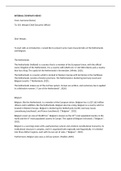INTERNAL COMPANY MEMO
From: Surname (Name)
To: B.R. Wergie (Chief Executive Officer)
Dear Wergie,
To start with an introduction, I would like to present some main characteristics of the Netherlands
and Belgium.
The Netherlands
The Netherlands (Holland) is a country that is a member of the European Union, with the official
name, Kingdom of the Netherlands. It is a country with (2020 est.) 17,427,000 citizens and a country
that has a king. The capital of the Netherlands is Amsterdam. (Wintle, 2021).
The Netherlands is a country which is located in Western Europe with territories in the Caribbean.
The Netherlands consists of twelve provinces. The Netherlands is bordering Germany (east) and
Belgium (south). (‘’Netherlands, 2021).
The Netherlands makes use of the civil law system. Its laws are written, and customary law is applied
in a distinctive manner. (‘’Law of the Netherlands’’, 2020).
Belgium
Belgium, like the Netherlands, is a member of the European Union. Belgium has 11,507,163 million
citizens and in addition, like the Netherlands, Belgium also has a king. Belgium is a country which is
located in Western Europe. Belgium is bordering the Netherlands (north), Germany (east),
Luxembourg (southeast), and France (southwest). (‘’Belgium’’, 2021).
Belgium covers an area of 30,689 km2. Belgium is known as the 22nd most populated country in the
world and the 6th most populated country in Europe. The capital of Belgium is Brussels. (‘’Belgium’’,
2021).
Belgium is a sovereign state with a parliamentary system and a federal constitutional monarchy. Its
institutional structure is complex, and it is organized both regionally and linguistically. It is divided
into three distinct regions, each with its own set of rules. (‘’Belgium’’, 2021).
Furthermore, Belgium also uses a civil law system. (Malliet, 2005).
, Chapter 1. Establishing a foundation
Research methodology
To answer your first question I used Dutch websites that deal with the regulations regarding
establishing a foundation in the Netherlands. This research methodology was used because the
(original) Dutch websites provide the most comprehensive and clear information since it is about
their own country.
The Netherlands
According to Ondernemersplein (n.d.), setting up a foundation is possible in the Netherlands. For
this, you have to go to the notary and he will draw up a notarial deed with the statutes. It is possible
to establish the foundation alone or together with others. In addition, according to Stichting
Oprichten (2021), the advantage of setting up a foundation is that it is a legal form with limited
liability according to Dutch law. This means that directors are not jointly and severally liable for any
debts of the foundation. According to Hoekstra (2020), the disadvantage of starting a foundation is
that according to Dutch law it is not allowed to distribute any profits to yourself, and in addition, you
receive no salary.
Research methodology
To answer the same question for Belgium, I used Belgium websites that deal with the regulations on
starting a foundation in Belgium. Also for Belgium this research methodology was used for the same
reason as for the Netherlands. The (original) Belgian websites provide the most clear and
comprehensive information regarding their regulations on establishing a foundation.
Belgium
Also in Belgium, according to Cultuurloket (2020), it is possible to start a foundation. For this, the
founders must first start a recognition procedure with the FPS Justice. After the recognition, the
articles of association can be filed with the clerk’s office of the Enterprise Court. The same
advantages and disadvantages for starting a foundation also apply to Belgium as in the Netherlands.
To conclude it can be said that it is possible for both countries to establish a foundation.





